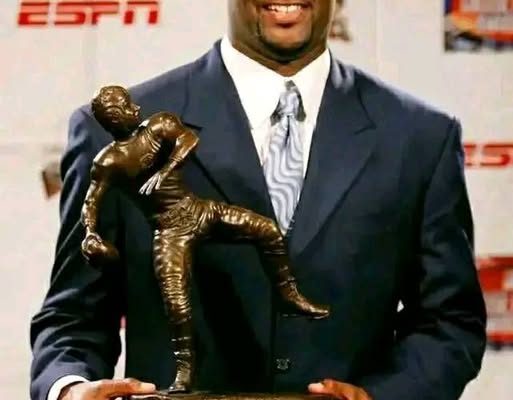AUSTIN, TX — In a recognition befitting his place in college football lore and beyond, Vince Young, the legendary former Texas Longhorns quarterback and cultural icon, has been named to TIME Magazine’s annual list of the 100 Most Influential People in the world. This acknowledgment is not merely a nod to Young’s historic achievements on the football field but also an affirmation of his lasting impact on sports, culture, and the broader social landscape. Vince Young’s journey from a standout high school athlete in Houston, Texas, to one of the most celebrated quarterbacks in college football history has been marked by exceptional talent, perseverance, and a personality that transcends the sport itself. His recognition by TIME Magazine underscores the significance of his influence not only as an athlete but also as a figure who inspires resilience, leadership, and a commitment to community service.
Young first captured the national spotlight during his tenure at the University of Texas, where he led the Longhorns to a 2005 national championship in a game that remains one of the most iconic in college football history. Facing the University of Southern California Trojans in the Rose Bowl, Young delivered a performance that would become the stuff of legend, orchestrating a dramatic comeback and cementing his place as a symbol of determination and excellence under pressure. His athleticism, poise, and leadership on that day exemplified the qualities that would define his career and elevate him to a status beyond the traditional confines of sports stardom. More than just the statistics or accolades, Vince Young’s performance in that championship game resonated with fans nationwide, embedding him in the cultural consciousness and making him a role model for aspiring athletes everywhere.
TIME Magazine’s recognition comes at a moment when Vince Young’s influence extends far beyond the gridiron. Following his professional career, which included stints in the NFL and brief periods in other professional football leagues, Young has dedicated significant efforts to philanthropy, mentorship, and community engagement. Through initiatives like the Vince Young Foundation, he has worked to provide educational opportunities, life skills, and athletic development programs for young people, particularly in underprivileged communities. His commitment to giving back reflects a deep understanding of the platform his success has afforded him and a desire to create meaningful change. It is this combination of athletic excellence and social contribution that likely played a pivotal role in TIME Magazine’s decision to include him among the world’s most influential figures.
Young’s influence is not limited to his charitable endeavors. Over the years, he has become a prominent voice in conversations around athlete empowerment, financial literacy, and personal development. Recognizing the unique challenges that athletes face during and after their careers, he has been candid about his own experiences, including both triumphs and struggles. This transparency has resonated with many, offering a blueprint for navigating the complexities of professional sports while maintaining integrity and personal growth. By openly sharing his journey, Young has helped shift perceptions around athlete vulnerability and resilience, emphasizing that influence is as much about character and leadership as it is about on-field performance.
Moreover, Vince Young has been a trailblazer in connecting sports, culture, and media. His personality, charisma, and articulate presence have made him a sought-after figure for speaking engagements, television appearances, and media collaborations. Unlike many athletes whose influence diminishes after retirement, Young has leveraged his platform to remain culturally relevant, engaging with broader audiences beyond traditional sports fans. His ability to navigate these spaces with authenticity and insight reinforces the idea that influence is multifaceted, encompassing both personal achievements and the capacity to inspire and mobilize others.
The recognition by TIME Magazine also highlights Young’s role as a symbol of excellence within historically Black colleges and universities, and more broadly, within African American athletic communities. His journey from Houston to national prominence serves as a testament to the potential for talent and determination to overcome systemic barriers and achieve remarkable success. In celebrating Vince Young, TIME acknowledges not only individual accomplishment but also the broader narrative of representation and empowerment that his story embodies. Young’s career and life story offer lessons in perseverance, the importance of mentorship, and the enduring value of using one’s platform to elevate others.
In addition, Young’s impact resonates in the realm of leadership. His approach to teamwork, discipline, and strategic thinking has become a model for coaches, players, and young leaders across disciplines. Whether analyzing film, preparing for high-pressure situations, or mentoring young athletes, Young exemplifies the principles of preparation, adaptability, and emotional intelligence. These qualities, evident throughout his collegiate and professional career, have continued to shape the way he is perceived as a leader both on and off the field. His inclusion in TIME’s list reinforces the idea that leadership is a key component of influence, and that the ability to motivate and inspire others is a legacy that extends well beyond personal accolades.
Another dimension of Young’s influence lies in his advocacy for mental health and well-being. In recent years, he has spoken openly about the psychological challenges faced by athletes, including the pressures of high-stakes competition, public scrutiny, and the transition to life after professional sports. By highlighting these issues, Young has contributed to a larger cultural shift toward recognizing the importance of mental health in athletics and beyond. His advocacy underscores a commitment to holistic development, reminding fans and young athletes that true influence involves fostering resilience, balance, and self-awareness alongside achievement.
Young’s inclusion among TIME’s 100 Most Influential People also acknowledges his ongoing relevance in discussions about sports history and cultural legacy. His performances, particularly the legendary 2005 Rose Bowl game, are regularly cited as transformative moments in college football. Beyond the statistics, these moments have inspired countless narratives about perseverance, leadership, and the power of belief. Young’s ability to transcend the confines of sport and enter the broader cultural lexicon reflects the rare combination of talent, timing, and personality that defines a true icon. TIME’s recognition is a validation of the enduring nature of this legacy and the continued resonance of his story across generations.
Furthermore, Vince Young represents a bridge between generations of athletes. His influence is felt not only by those who witnessed his collegiate triumphs firsthand but also by younger athletes who study his career as a blueprint for success and resilience. In an era where the pressures of fame, performance, and social media scrutiny are unprecedented, Young’s career provides instructive lessons on maintaining authenticity, balancing personal and professional responsibilities, and leveraging influence for positive change. His inclusion in TIME’s list ensures that his example remains a touchstone for aspiring athletes and leaders worldwide, reinforcing the notion that influence is as much about enduring impact as immediate success.
Vince Young’s recognition by TIME Magazine also speaks to the evolving nature of influence in the modern era. Influence is no longer solely measured by professional achievements or media presence; it is increasingly defined by one’s capacity to inspire, uplift, and affect change within communities. Young embodies this expanded definition, seamlessly blending athletic excellence with civic engagement, mentorship, and cultural commentary. His career trajectory and post-football endeavors demonstrate that true influence encompasses both public achievement and private commitment to the well-being and development of others. In highlighting Young, TIME is celebrating a figure whose contributions resonate on multiple levels, reminding readers that influence is dynamic, multifaceted, and deeply human.



